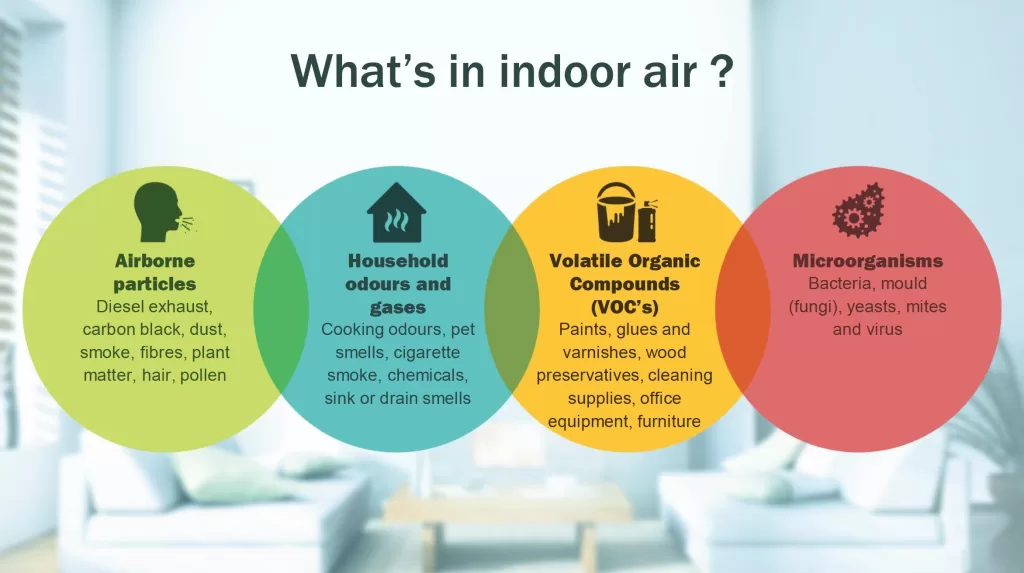Indoor air quality has become an increasingly vital concern, especially as we navigate health challenges posed by airborne biothreats. The recent launch of the Building Resilient Environments for Air and Total Health (BREATHE) program by the Advanced Research Projects Agency for Health (ARPA-H) highlights this need, aiming to enhance indoor environments across the country. This initiative not only emphasizes the significance of monitoring air quality in smart buildings but also focuses on real-time interventions to safeguard public health. By engaging a diverse range of experts in biosensor technology and data analysis, the BREATHE program is poised to address critical gaps in our understanding and management of indoor air quality. As advocates of health and safety, we must prioritize improving the air we breathe within our homes, workplaces, and public spaces, especially when most of us spend up to 90% of our lives indoors.
The focus on maintaining healthy air within indoor environments has gained traction with the introduction of advanced programs that target environmental health issues. This movement to enhance the conditions and safety of air within buildings involves the integration of innovative technologies that actively monitor pollutants and enhance ventilation. Such initiatives recognize the significant amount of time individuals spend indoors, emphasizing the critical need for clean, safe air for overall well-being. Moreover, with the threat of airborne diseases becoming more apparent, creating resilient indoor environments is now a priority. Programs addressing these concerns are stepping up public awareness and targeting systemic improvements necessary for robust health outcomes.
The Importance of Indoor Air Quality for Health
Indoor air quality (IAQ) is a critical aspect of public health that can greatly impact our overall well-being. Poor IAQ is linked to a range of health issues, from allergies and respiratory diseases to severe conditions like asthma. With populations spending up to 90% of their time indoors, as noted by the BREATHE program, it’s crucial to address the contaminants that may be lurking in our living and working environments. The BREATHE initiative under ARPA-H aims to tackle these pressing issues by focusing on the development of advanced biosensors that can detect airborne biothreats swiftly, ensuring that our spaces are safe and health-promoting.
As awareness of the importance of IAQ grows, there is a push for integrating smarter technologies in buildings. The smart buildings concept is at the forefront of this change, allowing for real-time monitoring and management of air quality. Enhanced ventilation systems, automated disinfection protocols, and continuous air quality assessments all play a role in mitigating potential health threats. Comprehensive strategies like these can significantly reduce the incidence of health problems associated with poor indoor air quality, illustrating the need for sustained public health initiatives like the BREATHE program.
The BREATHE program aims to revolutionize how we perceive and handle indoor air quality. With a focused approach on biosensors and risk assessment tools, it promises to empower healthcare systems and public health officials to make informed decisions that prioritize the health of individuals in various indoor settings, from homes to hospitals. By leveraging cutting-edge technology and data analysis, the program not only seeks to identify existing air quality issues but also to predict and prevent future problems before they escalate into serious health threats.
Furthermore, the integration of smart building technology into new and existing infrastructures underscores a significant shift in public health strategy. By utilizing advanced building automation systems that connect with health-monitoring devices, stakeholders can ensure that air quality is maintained at optimal levels. This proactive approach not only protects public health but also enhances the overall efficiency and sustainability of buildings.
Advancements from the BREATHE Program
The BREATHE program introduced by ARPA-H has the potential to make significant advancements in indoor air quality management. By integrating sophisticated biosensor technology capable of detecting airborne biothreats, the program aims to create safer environments, especially in high-traffic areas such as schools, hospitals, and offices. This approach highlights the importance of rapid detection capabilities, allowing for immediate responses to air quality concerns and enabling timely interventions that can significantly reduce health risks.
In addition to biosensors, the BREATHE program emphasizes the need for effective risk assessment software. Such tools will help building managers, public health officials, and facility operators evaluate the potential impact of various airborne pollutants on human health. These assessments can guide proactive measures, from enhanced ventilation to the installation of advanced filtration systems, ultimately leading to an overall improvement in indoor air quality and public health outcomes.
Moreover, the program’s focus on optimizing building controls aligns with the growing trend of smart building technologies. By utilizing automated systems that respond to real-time data, buildings can adjust their ventilation rates, humidity levels, and temperature to enhance air quality. These adjustments not only help in maintaining healthier environments but also promote energy efficiency, which is crucial in the context of climate change and rising energy costs. Therefore, the BREATHE program’s innovations could lead to dual benefits for both public health and sustainability efforts.
The involvement of diverse experts in the BREATHE program signifies a collaborative approach to addressing these challenges. By bringing together professionals from various fields, such as data analysis, healthcare systems, and property management, the program is positioned to develop holistic solutions that effectively tackle indoor air quality issues. As these advancements unfold, they will pave the way for a future where indoor spaces are safer, healthier, and more sustainable.
The Role of Smart Buildings in Enhancing IAQ
Smart buildings represent a revolutionary concept in architecture and urban planning, focusing on technology integration to optimize operational efficiency and improve living conditions. One key aspect of this model is its emphasis on enhancing indoor air quality (IAQ). The BREATHE program is at the fore of this evolution, promoting the development of systems capable of continuously assessing air quality and enabling timely interventions, such as increasing ventilation or activating disinfection protocols. This technology not only helps eliminate airborne biothreats but also fosters a more responsive building environment tailored to the needs of its inhabitants.
In smart buildings, harnessing data-driven decision-making processes allows for better management of air quality. By utilizing advanced sensors and automated controls, these environments can detect fluctuations in pollution levels and react accordingly—whether through automated filtration systems or by alerting facility managers to potential health hazards. Such dynamic systems significantly contribute to improved occupant health, productivity, and overall well-being, showcasing how innovation can transform traditional building management practices.
Furthermore, smart buildings designed with IAQ in mind are setting new standards in public health initiatives. The collaboration between technology providers, healthcare experts, and building managers is crucial for implementing successful strategies that ensure occupant safety. The BREATHE program aims to harness this collaborative spirit, driving further research and development in the field of smart building technologies while addressing indoor air threats effectively.
Additionally, as urban areas continue to grow, the adoption of smart building practices becomes increasingly vital. By prioritizing indoor air quality and health through intelligent design and technology, cities can set a precedent for healthier living environments. The BREATHE program illustrates how marrying innovation with public health objectives can lead to unprecedented improvements in the spaces we inhabit every day, ultimately contributing to a decline in respiratory illnesses and other health-related issues linked to poor air quality.
Combatting Airborne Biothreats with Innovative Strategies
Airborne biothreats present a significant challenge to public health, especially in densely populated areas. The BREATHE program launched by ARPA-H aims to address this critical issue head-on by introducing innovative strategies to detect and mitigate these threats in real time. With advancements in indoor air biosensor technology, facilities can now monitor air quality indicators closely and detect dangerous pathogens before they have a chance to impact health outcomes. This proactive approach not only enhances individual safety but also helps safeguard community health.
By focusing on rapidly identifying airborne biothreats, the BREATHE program empowers both building operators and public health officials to take informed steps in managing potential outbreaks. Through the integration of these sophisticated technologies, facilities can implement immediate responses, such as increasing air filtration or initiating disinfection processes, to reduce the risk of infection. This swift action is particularly crucial in healthcare settings, where patients with compromised immune systems require exceptionally safe environments.
In conjunction with biosensors, the risk assessment software developed under the BREATHE initiative will aid in evaluating the consequences of exposure to airborne pathogens. This software enables building managers to forecast health risks associated with various indoor air quality scenarios, translating data into actionable insights. By understanding the possible health impacts in advance, organizations can develop policies and procedures that prioritize the health of occupants and reduce vulnerabilities to airborne biothreats.
Ultimately, the BREATHE program serves as a model for how public health initiatives can evolve to meet modern challenges. By fostering a culture of innovation and research within the realms of environmental health and building management, ARPA-H is setting the stage for a future where we can achieve safer indoor environments across the nation.
Public Health Initiatives and Integrating Air Quality Solutions
Public health initiatives aimed at improving indoor air quality are becoming increasingly critical in our changing world. The BREATHE program seeks to bridge gaps in research and technology to enhance the well-being of communities. With a focus on innovative solutions, this initiative aims to establish comprehensive frameworks for assessing and improving indoor air quality in various settings, addressing crucial elements that affect human health.
By engaging experts from multiple fields, such as healthcare, environmental science, and technology, the BREATHE program is harnessing the collective knowledge necessary to confront the challenges associated with indoor air quality. Such collaborative efforts emphasize the significance of interdisciplinary approaches to public health that not only recognize the importance of air quality but also promote long-term research and investment in sustainable solutions.
As we witnessed during the COVID-19 pandemic, the quality of air we breathe indoors can have profound effects on our health and well-being. The BREATHE initiative aims to learn from these experiences, prioritizing the improvement of indoor air quality as an essential component of effective public health strategies. By developing actionable frameworks and facilitating thewide implementation of biosensors and monitoring tools, it is possible to create healthier environments for everyone.
Implementing air quality solutions as a part of public health initiatives not only protects individuals but also fosters resilience within communities. By educating the public about the significance of indoor air quality and engaging stakeholders in this mission, the BREATHE program is taking important steps toward nurturing a more informed society that advocates for health-enabling environments.
Frequently Asked Questions
What is the BREATHE program and how does it relate to indoor air quality?
The BREATHE program, announced by ARPA-H, focuses on improving indoor air quality by developing smart building technologies that monitor and manage air quality in real time. This public health initiative aims to mitigate airborne biothreats through integrated systems that enhance ventilation and disinfection capabilities.
How does ARPA-H’s BREATHE program improve public health through indoor air quality?
The BREATHE program by ARPA-H seeks to improve public health by revolutionizing indoor air quality monitoring and management. By deploying smart building technologies that can detect airborne biothreats and optimize air quality control systems, the program addresses health risks associated with poor indoor air conditions.
What technologies will be used in the BREATHE program to ensure better indoor air quality?
The BREATHE program plans to use biosensors for rapid detection of airborne biothreats and develop risk assessment software to evaluate health impacts. These technologies are designed to integrate into smart buildings to improve indoor air quality and enhance overall health outcomes.
Why is monitoring indoor air quality crucial according to the BREATHE program?
Monitoring indoor air quality is critical, as statistics show that Americans spend 90% of their time indoors. As highlighted by the BREATHE program, the ability to continuously assess and manage indoor air quality can directly address the health risks posed by airborne threats, enhancing public health.
How can smart buildings contribute to indoor air quality improvements under the BREATHE initiative?
Smart buildings can significantly contribute to indoor air quality improvements by utilizing automated systems that continuously evaluate air quality, implement real-time solutions for ventilation, and manage disinfection processes. This proactive approach, supported by the BREATHE program, aims to reduce health risks from poor indoor air.
What role do airborne biothreats play in the BREATHE program’s focus on indoor air quality?
Airborne biothreats are a central concern of the BREATHE program, as they can severely impact health in indoor environments. By developing rapid detection technologies and enhancing indoor air quality measures, the program aims to protect users from these health risks.
What collaborative efforts are involved in the BREATHE program to tackle indoor air quality challenges?
The BREATHE program involves collaboration among experts in various fields, including healthcare, biosensor development, and building automation. These collaborations are essential for creating solutions that effectively improve indoor air quality and address public health concerns.
How does the BREATHE program plan to enhance energy efficiency while improving indoor air quality?
The BREATHE program aims to optimize building control systems to enhance both health and energy efficiency. By integrating technologies that monitor indoor air quality, the initiative ensures that improvements in ventilation and disinfection are achieved without compromising energy performance.
| Key Point | Description |
|---|---|
| Launch of BREATHE Program | Aimed at improving indoor air quality across the country, focusing on smart building technologies. |
| ARPA-H Overview | Established to support biomedical and health research, proposed by the Biden Administration and approved in March 2022. |
| Smart Buildings | Buildings equipped with integrated systems that assess and report indoor air quality for real-time health interventions. |
| Technical Areas of Focus | 1. Indoor air biosensors for detecting airborne biothreats. 2. Respiratory risk assessment software. 3. Optimization of building controls for health and energy efficiency. |
| Importance of Indoor Air Quality | During the pandemic, it became clear that monitoring indoor air quality is critical for health, as people spend 90% of their lives indoors. |
| Public Health Revolution | BREATHE aims to transform public health by eliminating indoor air threats, highlighting the urgency of improved air quality monitoring. |
Summary
Indoor air quality is increasingly recognized as a vital aspect of public health. The recent launch of the BREATHE program by ARPA-H underscores the urgent need for innovative solutions to improve the air we breathe indoors. By focusing on smart building technologies and biosensors, the program aims to directly address airborne health threats, marking a significant step towards ensuring healthier indoor environments. As we move forward, continued investment and attention to indoor air quality will be essential in safeguarding public health.
The content provided on this blog (e.g., symptom descriptions, health tips, or general advice) is for informational purposes only and is not a substitute for professional medical advice, diagnosis, or treatment. Always seek the guidance of your physician or other qualified healthcare provider with any questions you may have regarding a medical condition. Never disregard professional medical advice or delay seeking it because of something you have read on this website. If you believe you may have a medical emergency, call your doctor or emergency services immediately. Reliance on any information provided by this blog is solely at your own risk.








